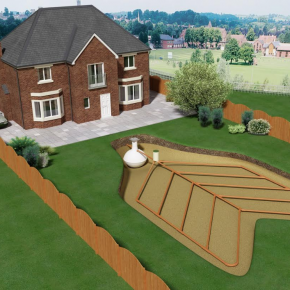
JDP wising up on impending changes to Septic Tank Legislation
JDP have created a guide that will help people achieve compliance with the general binding rules for sewage systems.
All septic tanks in England and Wales that discharge into a watercourse or a ditch will need to be replaced by 1 January 2020, because of a direct result of new rules that have been introduced to address the concerns that waste water is polluting watercourses.
With less than a year to go, it is estimated that an incredible 60% of sites do not currently meet the requirements of the new legislation.
If you currently own a non-compliant septic tank, you have two options available to you in order to comply with these new rules before the deadline (unless you live in Scotland or Ireland, as different rules apply to you).

Change your system to discharge into a drainage field
You can keep your existing septic tank system, but discharge the waste into a drainage field instead of the watercourse. Things to bear in mind when considering this option is that a drainage field needs to be:
- 10 metres from any watercourse;
- 15 metres from any building;
- 50 metres from any water supply;
- clear of any access roads, driveways, or paved areas.
If you choose to install a new drainage field, it must comply with BS 6297:2007. In addition, if the new drainage field is going to be in or near a designated sensitive area, you will need to apply for a permit from the Environment Agency. If you’re not sure if you need a permit, the Agency will be able to tell you.
Replace your septic tank with a small sewage treatment plant
If installing a drainage field isn’t practical, you can opt to replace your septic tank with a small sewage treatment plant instead.
Any new small sewage treatment plant must have full BS EN 12566-3 certification, but the new rules still allow for wastewater from a plant to be discharged into a watercourse, as the sewage undergoes further treatment.
Anyone considering this option needs to remember that small sewage treatment plants either need a power supply that cannot be interrupted, or can operate without power for up to six hours.
Time for a choice
If you’re one of the 60% who needs to change their sewage system and the choice seems a little daunting, don’t worry. There’s still time before the deadline, and a company like JDP can help.
With over 45 years of expertise in drainage and water management, and a huge range of both septic tanks and treatment plants available, it can talk through the benefits of both types of system and offer you free advice tailored to your individual needs.
One last thing to bear in mind is that, whether you install a new drainage field or replace your septic tank, the new rules also require you to make sure your system is maintained properly and does not cause pollution.
This might seem like common sense, but there are a number of things you need to be aware of, so we’ve created a guide to help you comply with the general binding rules for sewage systems.
Visit Supplier's page
Latest news

28th March 2025
Ideal Heating Commercial announces 10-year warranty on Evomax 2 boiler
Evomax 2, the UK’s number one selling commercial wall-mounted boiler from Ideal Heating Commercial, is now available with a 10-year warranty.
Posted in Articles, Building Industry News, Building Products & Structures, Building Regulations & Accreditations, Building Services, Facility Management & Building Services, Heating Systems, Controls and Management, Heating, Ventilation and Air Conditioning - HVAC, Innovations & New Products, Pipes, Pipes & Fittings, Plumbing, Retrofit & Renovation, Sustainability & Energy Efficiency, Videos
28th March 2025
FLIR Si1-LD Acoustic Imaging Camera for Compressed Air Leak Detection
FLIR, a Teledyne Technologies company, introduces the Si1-LD, an industrial acoustic imaging camera that brings faster and more accurate compressed air leak detection to those operating on a modest condition monitoring budget.
Posted in Acoustics, Noise & Vibration Control, Articles, Building Industry News, Building Products & Structures, Building Services, Facility Management & Building Services, Information Technology, Innovations & New Products, Retrofit & Renovation, Sustainability & Energy Efficiency, Thermal Imaging and Monitors
28th March 2025
LIFTEX 2025 Seminar programme announced
Registration has opened for LIFTEX 2025. Now in its 37th year, LIFTEX 2025 is the UK’s only dedicated exhibition for the lift, escalator and access industry and takes place only once every three years.
Posted in Access Control & Door Entry Systems, Accessibility, Articles, Building Industry Events, Building Industry News, Building Products & Structures, Building Regulations & Accreditations, Building Services, Exhibitions and Conferences, Facility Management & Building Services, Health & Safety, Retrofit & Renovation, Security and Fire Protection, Seminars
28th March 2025
MCRMA welcomes ArcelorMittal UK to membership
A UK division of the global steelmaking business ArcelorMittal has become the latest new member of the MCRMA, the industry association representing the metal building envelope sector.
Posted in Articles, Building Associations & Institutes, Building Industry News, Building Products & Structures, Building Systems, Cladding, Facades, Posts, Restoration & Refurbishment, Retrofit & Renovation, Roofs, Steel and Structural Frames, Walls
 Sign up:
Sign up: